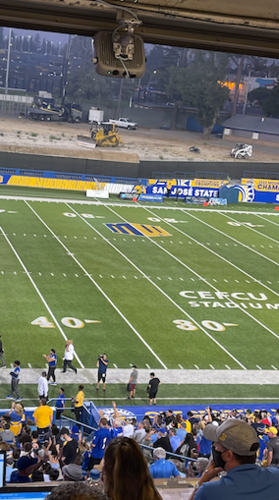San Jose State recently held its first Fall 2021, fully open, football game. As we knew this was coming, we prepared the stadium for the re-opening after it sat idle for way too long. As part of the preparation, we chose to revamp the wireless network at the stadium and leverage the new Wi-Fi 6 Cisco Catalyst 9104 Stadium Antennas to service clients at 150 to 200 feet. We also upgraded to the new Catalyst 9124 Wi-Fi 6 outdoor wireless access points for shorter distances.
Outdoor Wi-Fi 6 with Mesh
We found the Catalyst 9124 to be very versatile outdoor wireless access point allowing us to tune for directional, omni or even use it with an external antenna. The mesh-ability of the Catalyst 9124 is impressive and robust. Wireless is used in concession stands, ticket scanning stations, parking entrances and beer gardens, the ability to deploy a reliable mesh Wi-Fi provides a lot of flexibility in extending wireless as needed. This is important as the requirements change from event to event.
Another must have is the ability to setup an RLAN port on the Catalyst 9124s, which allows us to connect PoE cameras or any other PoE device. This gives us the ability to add cameras at the wireless access point locations without additional wiring or power needs.

We control both outdoor and indoor wireless infrastructure with the Cisco Catalyst 9800 wireless controller with IOS-XE software version 17.6.x or higher. 17.6 is the minimum software release needed to support the Catalyst 9104 and its software configurable antennas. It’s also needed to support mesh deployments as discussed above.
OpenRoaming is changing the face of guest access
As we are a college campus we have our campus SSID and the Eduroam SSID for our students, faculty, staff and visiting teams. For non-school affiliated spectators we historically provided a captive portal requiring users to enter name, and email in order to get access to the Internet. I have always been disappointed at the relatively low take rate of users to the portal. The more I thought about it, the more I realized, this is all about the visitors and their ability to connect.
In our current time of unlimited LTE data plans, why would anyone bother with a captive portal and sign-in. However if they could connect with a single “ok to join” request, they would be far more inclined. This is where the OpenRoaming concept works very well. When an OpenRoaming SSID is present, phones and devices prompt users that there is a public network available and asks if they want to join. And if they’ve already joined an OpenRoaming network in the past, they’ll just automatically connect.
Reducing reliance on captive portals
Captive portals have a number of good use cases, but there is an equally important case for just allowing users to connect, even if you know less about them. We can still track analytics, and the analytics are far more insightful when we have a higher connect rate, like we’ve seen with OpenRoaming. For example, with more uses on, we can estimate wait lines at concession stands, understand foot traffic patterns, and dispatch janitorial services to a restroom after predetermined number of visitors to name a few.
To test my theory of high function vs ease of connectivity, I enabled OpenRoaming in addition to the Captive Portal SSID and saw interesting findings and user behavior:
- Out of 855 attached clients to the captive portal SSID – only 20% were authenticated, meaning they did not enter the information required to gain network access.
- More than 2600 clients attached to the OpenRoaming network were all automatically authenticated and using the network
- 3400 clients were on the campus SSID or Eduroam SSID.
One of my takeaways here is that even with great wireless connectivity with the latest WiFi6 technology, if you want users on your network, onboarding must be seamless!
Learn more about Cisco wireless solutions.
Check out other posts from Shai Silberman.
Subscribe to the Networking blog!
Check out our Intent-Based Networking Video Channel


CONNECT WITH US